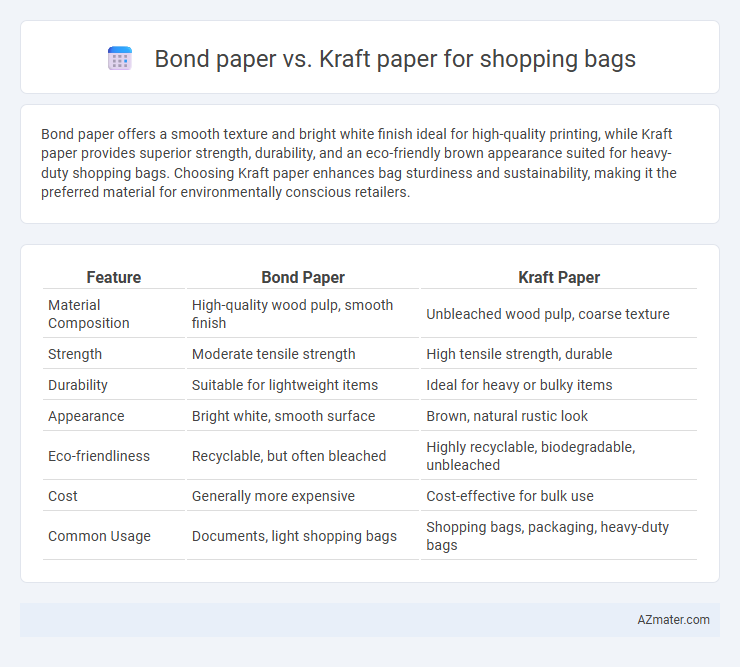Bond paper offers a smooth texture and bright white finish ideal for high-quality printing, while Kraft paper provides superior strength, durability, and an eco-friendly brown appearance suited for heavy-duty shopping bags. Choosing Kraft paper enhances bag sturdiness and sustainability, making it the preferred material for environmentally conscious retailers.
Table of Comparison
| Feature | Bond Paper | Kraft Paper |
|---|---|---|
| Material Composition | High-quality wood pulp, smooth finish | Unbleached wood pulp, coarse texture |
| Strength | Moderate tensile strength | High tensile strength, durable |
| Durability | Suitable for lightweight items | Ideal for heavy or bulky items |
| Appearance | Bright white, smooth surface | Brown, natural rustic look |
| Eco-friendliness | Recyclable, but often bleached | Highly recyclable, biodegradable, unbleached |
| Cost | Generally more expensive | Cost-effective for bulk use |
| Common Usage | Documents, light shopping bags | Shopping bags, packaging, heavy-duty bags |
Introduction to Bond Paper and Kraft Paper
Bond paper, known for its smooth texture and high durability, is widely used in shopping bags requiring a clean, professional appearance and excellent print quality. Kraft paper, characterized by its coarse texture and natural brown color, offers superior strength and eco-friendly properties, making it ideal for heavy-duty shopping bags with a rustic aesthetic. Selection between bond paper and kraft paper depends on desired durability, print finish, and environmental considerations in shopping bag production.
Material Composition and Characteristics
Bond paper, made primarily from wood pulp with a smooth finish and high tensile strength, offers durability and printability ideal for shopping bags requiring detailed graphics and a polished look. Kraft paper is composed of unbleached wood pulp through the kraft process, providing superior tear resistance, natural brown color, and eco-friendly recyclability favored for heavy-duty, rustic-style shopping bags. The choice between bond and kraft paper depends on desired aesthetics, strength, and environmental considerations of the shopping bag material composition.
Strength and Durability Comparison
Bond paper, typically smoother and lighter, offers moderate strength suitable for lightweight shopping bags but may tear under heavy loads. Kraft paper, known for its robust fiber composition and natural brown color, provides superior tensile strength and durability, making it ideal for carrying heavier items without ripping. The enhanced durability of Kraft paper bags ensures better resistance to moisture and wear, outperforming bond paper in long-term reliability for shopping bag applications.
Environmental Impact and Sustainability
Bond paper, typically made from bleached wood pulp, has a higher environmental footprint due to chemical processing and lower recyclability compared to kraft paper, which is produced from unbleached, natural fibers and is biodegradable. Kraft paper's durability and ability to decompose quickly make it a more sustainable choice for shopping bags, supporting eco-friendly packaging initiatives. Choosing kraft paper reduces landfill waste and promotes a circular economy by enabling easier recycling and composting processes.
Cost and Economic Value
Bond paper offers a smoother finish and is generally more expensive than kraft paper, making it less cost-effective for shopping bags used in high-volume retail settings. Kraft paper provides superior strength and durability at a lower price point, optimizing economic value for businesses seeking sustainable yet affordable packaging solutions. Choosing kraft paper can reduce production costs while maintaining quality, enhancing overall profit margins in the shopping bag market.
Printability and Customization Options
Bond paper offers superior printability with a smooth surface that ensures sharp, vibrant images and text, making it ideal for high-quality branded shopping bags. Kraft paper, while more rustic and eco-friendly, has a rougher texture that can limit detailed printing but supports natural, earthy designs and is often preferred for minimalist customization. Both materials support various printing techniques like offset, flexographic, and digital printing, but bond paper provides more versatile and precise customization options for complex graphics and multicolor logos.
Weight and Load Capacity
Bond paper for shopping bags typically weighs between 75 to 100 gsm, offering moderate strength suitable for lightweight items, whereas kraft paper ranges from 120 to 200 gsm, providing superior durability and higher load capacity. Kraft paper's fibrous composition enhances tear resistance and supports heavier loads, often used for eco-friendly bags that carry groceries or bulkier products. Selecting kraft paper over bond paper significantly improves weight-bearing capability, reducing the risk of bag failure under moderate to heavy loads.
Aesthetic Appeal and Branding Potential
Bond paper offers a smooth, clean surface ideal for high-quality printing, enhancing the aesthetic appeal with sharp graphics and vibrant colors that elevate brand visibility. Kraft paper provides a rustic, natural look that appeals to eco-conscious consumers, boosting branding potential by conveying sustainability and authenticity. Choosing between bond and kraft paper depends on whether the brand prioritizes polished sophistication or organic, earthy charm in its shopping bag design.
User Experience and Practicality
Bond paper offers a smooth texture and crisp printing quality, enhancing brand visibility and user interaction with shopping bags. Kraft paper provides superior durability and eco-friendliness, making bags more practical for carrying heavier items and appealing to environmentally conscious consumers. Choosing between bond and kraft paper depends on balancing aesthetic appeal with strength and sustainability for optimal user experience.
Best Choice for Shopping Bags: Final Verdict
Kraft paper offers superior strength, durability, and eco-friendliness, making it the best choice for shopping bags that require heavy-duty use and recyclability. Bond paper, while smoother and suitable for printing, lacks the tensile strength needed for carrying heavier items and is less environmentally sustainable. For shopping bags prioritizing robustness and green credentials, Kraft paper remains the optimal material.

Infographic: Bond paper vs Kraft paper for Shopping bag
 azmater.com
azmater.com